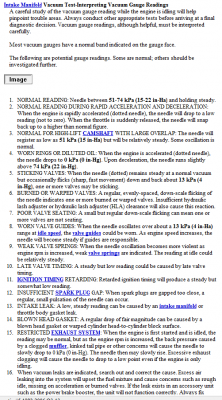LEOL
Full Access Members
So, Ive moderate mechanical experience including some professionally, but am NOT a professional Technician and dont have a ton of experience in vacuum diagnostics. I do have access to old software version of Alldata before it went full online service, and tend to read extensively any professional material i can find whenever im doing a project.
Im currently diagnosing a 5.4 3v with various possible issues, and ive run a vacuum test a few times. Ive tried to keep my vacuum connections and the actual procedure consistent, but gotten different results each time. It has however, consistently showed a steady reading at idle of about 18hg (23hg+ cuz im at 5200ft altitude) hot idle, which is in actuality probably a bit higher than normal BUT its at least steady.
when i do rpm holds is where i run into real wackyness. Some things changed since the first time so i basically have to disregard the previous tests. Currently it shows a slow steady drop, losing a total of about 5hg during a long 2500rpm hold, and snapping back fine upon release.

Now, according to most standard tips including that listed in this clip above from alldata procedures on this vehicle, this type of drop should indicate restricted exhaust flow.
i read one article (whether accurate or not) that implied lower than normal vacuum at constant higher rpm's should be normal (i cant find the article now to explain why), much like when you quick snap the throttle from idle it drops to zero momentarily.
anyway ive seen very little on what might produce a higher than average vacuum reading at idle, and coupled with a 5hg drop during long acceleration im a little confused as to how my readings should be interpreted. due to how vacuum works,... Is holding the throttle at 2500rpm's for 60+ seconds even going to give me a usable diagnostic reading???
If backpressure from a restricted exhaust causes dropping pressure on accelleration and more severe clogging/backpressure can cause it even at idle... then how am i getting a higher than usual reading at idle, but losing pressure during acceleration??? even if its two separate issues, they conflict. at least in my inexperienced mind anyway.... anyone have some in depth insight on this??
Im currently diagnosing a 5.4 3v with various possible issues, and ive run a vacuum test a few times. Ive tried to keep my vacuum connections and the actual procedure consistent, but gotten different results each time. It has however, consistently showed a steady reading at idle of about 18hg (23hg+ cuz im at 5200ft altitude) hot idle, which is in actuality probably a bit higher than normal BUT its at least steady.
when i do rpm holds is where i run into real wackyness. Some things changed since the first time so i basically have to disregard the previous tests. Currently it shows a slow steady drop, losing a total of about 5hg during a long 2500rpm hold, and snapping back fine upon release.

Now, according to most standard tips including that listed in this clip above from alldata procedures on this vehicle, this type of drop should indicate restricted exhaust flow.
i read one article (whether accurate or not) that implied lower than normal vacuum at constant higher rpm's should be normal (i cant find the article now to explain why), much like when you quick snap the throttle from idle it drops to zero momentarily.
anyway ive seen very little on what might produce a higher than average vacuum reading at idle, and coupled with a 5hg drop during long acceleration im a little confused as to how my readings should be interpreted. due to how vacuum works,... Is holding the throttle at 2500rpm's for 60+ seconds even going to give me a usable diagnostic reading???
If backpressure from a restricted exhaust causes dropping pressure on accelleration and more severe clogging/backpressure can cause it even at idle... then how am i getting a higher than usual reading at idle, but losing pressure during acceleration??? even if its two separate issues, they conflict. at least in my inexperienced mind anyway.... anyone have some in depth insight on this??

